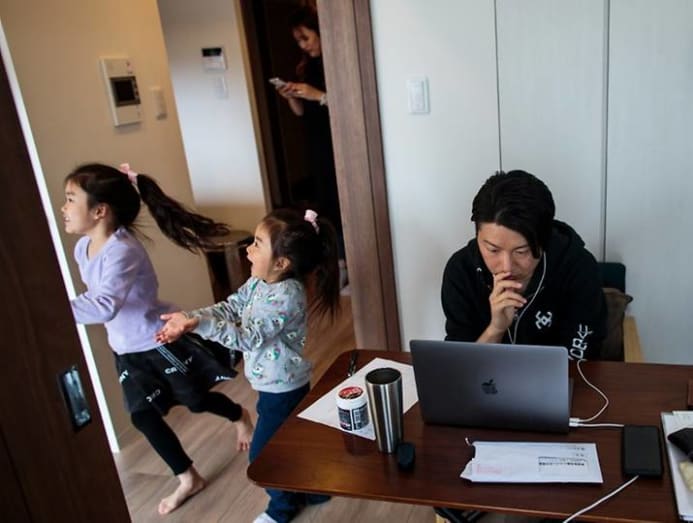Commentary: Why some workers in Singapore can’t wait to return to the office
Are those who want to return really sociopaths? There are costs to not being in the office all this time, says HR consultant Adrian Tan.

Some employees want to come back to the office despite the benefits of working from home. (Photo: iStock/vichie81)
SINGAPORE: In what must be unprecedented in work history, Singapore has undergone the biggest work-from-home exercise, thanks to COVID-19.
What the Government struggled to encourage employers for years was achieved in mere weeks by the pandemic.
With companies forced to institutionalise work-from-home (WFH) or be penalised for not keeping to pandemic health rules, many scrambled to figure out how to conduct business without any in-person interaction.
It was a steep learning curve. Laptops replaced desktops, internet connectivity (and family relationships) were put through a thorough stress-test and everyone in the country now has a Zoom account. Without a lack of alternatives, we were forced to adapt and soon found there were huge benefits to WFH.
READ: Commentary: Why are some people less productive than others when working from home?
We saved on commuting time and transportation costs. We worked in pyjamas and did less laundry. With flexible time, I could go to the gym at 9am and have tea at 3pm – so long as my work for the day was done.
Personal Finance Comparison site SingSaver did a calculation for two of their employees and found that working remotely helped them to save between S$400 to S$600 per month.
The benefits also extended to businesses as they cut back on office space.
DBS Bank plans to surrender about two and a half floors or 75,000 square feet in Tower 3 of the Marina Bay Financial Centre. Citigroup and Mizuho are also cutting space on the back of work from home success.
READ: Commentary: Nobody wants to return to a five-day work week as it was
THE COSTS PILE UP
But we need to be clear-eyed about this dream scenario where everyone is productive and happy working out of their bedrooms. While the Government announced work-from-home will remain the default on Wednesday (Jul 7), many workers like myself are looking forward to the day we can head back to the office with no caveats.

For me, it was dealing with four children at home, toggling their home-based learning requirements, space constraints and steady Internet connectivity that got me longing for my old office.
I experienced the last factor first-hand when there was a power trip in the middle of a webinar I was delivering. This would never happen in the office – even if there was an outage, a backup generator would have kicked in.
The reality is most of us are not born multitaskers and need distance to focus. National University Health System's (NUHS) Mind Science Centre did a survey in 2020 and found 61 per cent of those working from home reported feeling stressed, compared with 53 per cent of front-liners.
IT project manager Valerie Lim was one of the 1,407 survey respondents. She was juggling work productivity, managing her son’s home-based learning programme while keeping her younger daughter occupied.
With three of my kids in primary school, I too, like Valerie, have inevitably taken on a teaching assistant role every weekday morning. On certain days, I get more messages on Parents Gateway and ClassDojo combined than from my colleagues.
READ: Commentary: Surviving home-based learning in the long haul may require parents to dial back on kiasuism
Stress is not the only thing irritating folks jaded with working from home. The space constraint is a major problem. When we first bought our flat in 2016, my wife and I planned our home space usage based on how we wanted to live, with little expectation we would have to work in the exact same place.
I’ve had no choice but to work on the sofa, the dining table and even the bed when I needed to be in a quiet space for a meeting - all of which are horrible for work. I learnt the hard way this was no way to work with a relapse of my back problem after sitting on the hard dining chair for four hours straight.
It is little surprise senior principal physiotherapist John Abraham from Rapid Physiocare reported a significant increase in the number of WFH injuries since the circuit breaker.
ARE WE MORE EFFICIENT?
Sure, surveys show we are more productive when working from home but I wonder if that is because in saving time on commuting, we are simply converting these extra hours into work. It is not uncommon for people to start at 8am and not leave until well past 7pm.
But while we can get more done simply because we are spending more hours working, are we really more efficient?
I find myself spending more time playing Whatsapp/slack/email ping pong just to get a small task done. In the office, I simply walk over to my colleague and get things sorted in less than 10 minutes. The same exercise now can be as long as a tennis match with a back and forth of emails and messages.
READ: Commentary: It’s mostly sociopaths who want to go back to the office
Experts have long said without face to face communication, we have very little to help us discern what the other person is trying to tell us because we can’t see expressions or hear tone of voice.
Without these clarifying cues, we frequently “fill in the blanks” with assumptions and second-guesses which lead to unnecessary and time-consuming misunderstandings or miscommunications.

Overall, communication has become far more tedious in a WFH setting.
The other thing that has taken a big hit is ideation. The Zoom experience does not permit people to raise their points quickly (there is a built-in lag feature to prevent talking over each other). There’s something about painting out ideas together on a whiteboard which make creative ideas come about more easily.
This sense of collaboration and creativity died when are not in the room to argue, disagree and then come to a consensus. Zoom meetings too are often dominated by the one person whose job it is to get a project over the line.
READ: Commentary: Why annual leave seems less restful without travel and what to do about it
But the most important thing we have missed greatly by not being in the office? Socialising.
Aristotle said that “Man by nature is a social animal”. According to a Julianne Holt-Lunstad, a professor of psychology and neuroscience at Brigham Young University, lack of social connection heightens health risks as much as smoking 15 cigarettes a day or abusing alcohol. She also found that loneliness and social isolation are twice as harmful to physical and mental health as obesity.
When I asked my LinkedIn contacts what they miss about the office, more than 700 professionals said they can’t wait to return to the office and a whopping 60 per cent confessed they missed socialising most of all.
Most adults were lucky enough to experience this aspect of work life before COVID-19 hit. Far unluckier are recent graduates and new employees who have no chance to meet their colleagues or speak to people along the corridor or in the pantry.
I realised how much I missed having lunch with colleagues – just for an hour or two – to offload and discuss our shared experiences made the whole work experience better, one reason why I’m glad socialising with your colleagues in groups of five is allowed again from Jul 12.
READ: Commentary: What if people don’t want to return to the office?
Of course, COVID-19 won’t disappear just because we have decided to live with it. And we will still need to abide by safe management measures in the workplace like the cap of five (sorry sixth colleague) and to wear masks all day.
Recently Apple sent a memo asking their employees to return to the office three times a week as America winds down its battle with COVID-19.
In response, some employees pushed back. Their letter started from a Slack channel for “remote work advocates” with roughly 2,800 members.
The surprise is only 2 per cent of their workforce is insistent on not heading back to the office. For the other 98 per cent of Apple’s total employees, perhaps, returning a few days a week is a much needed desire to reset a most abnormal work experience.
I for one, could really use a proper desk and some peace and quiet from home - so I can work.
Adrian Tan is a Future of Work Strategist at the Institute for Human Resource Professionals.





